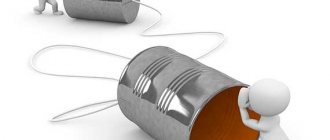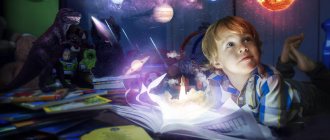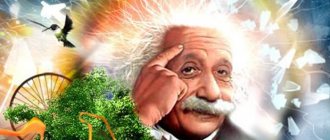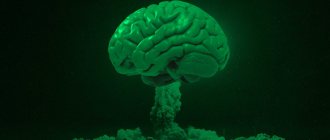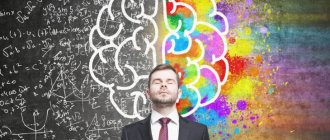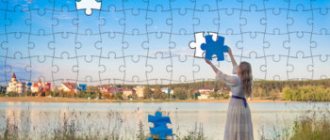After the lateral break was made, we had many mostly illogical (lateral) judgments. Now we have to take a step aimed at eliminating the resulting pattern gap. The upcoming stage is associated with work on the development of creative imagination to search and create full-fledged creative ideas from the metamorphoses obtained in the previous stages. In other words, in this class you will learn how to learn how to most effectively repair a lateral tear. This lesson describes the methods, principles and features of developing creative imagination, and also contains useful techniques, exercises and games.
What is creative imagination
Creative imagination is a type of imagination in which a person independently creates new images and ideas that are of a certain value. These ideas can be embodied in specific products of creative activity.
Also close to creative imagination and useful in the process of creative thinking is reconstructive imagination. Recreating imagination is the creation of images of objects that were not previously perceived by a person in a complete form, although he was already familiar with similar objects or their individual elements. In this case, the knowledge that a person already has about these objects is used, which determines the predominantly reproductive nature of the created images. At the same time, these images are distinguished from memory representations by a great diversity, flexibility and dynamism of elements. Simply put, the reconstructive imagination, unlike the creative one, is more consciously based on previous experience.
The peculiarity of imagination in the creative process is that it is imagination that is difficult to control when creating something new. If at the previous stages it was possible to describe an almost exact algorithm of actions, then the last stage should rely specifically on a person’s ability for creative imagination and associative thinking, you can read about the latter in a special lesson on memory development.
Definition of the concept
Recreating imagination is the projection in the mind of an image of some new object or phenomenon based on the presented verbal description, a conventional image.
A person can see a diagram or drawing of a future building and imagine in his mind, based on the information received, what it will look like when finished.
It is also enough to hear a verbal description of an object from the lips of an interlocutor in order to draw this object in your mind .
The ability to recreate new information, previously unknown, with the help of imagination, has a positive impact on human activity in various areas.
This skill is of particular importance for the learning process.
Only as a result of constructing vivid images in the mind of the objects and phenomena under consideration can a student learn new information in most areas of study .
Ability to find solutions to problems
Before moving on to tools for developing productive imagination, it is important to note that everyone has the ability to imagine creatively. The human mind has an important property, which is the presence of an incentive to eliminate logical contradictions.
For example, many smokers, knowing about the serious harm of smoking, always know how to explain to themselves and the people around them the reason why they do not give up this harmful habit. It turns out that smokers are faced with an internal contradiction “smoking is good - smoking is bad”, which in psychology is called cognitive dissonance (see Wikipedia). This contradiction causes psychological discomfort, and people are forced to come up with all possible ways to eliminate this contradiction, and some of them reflect the high creative abilities of a person: smoking can be harmful, but pleasant, smoking helps creativity, puts you in the right mood, helps train breathing, reduces weight etc. Almost every smoker has his own excuse, which was caused by a logical contradiction.
It turns out that a person is initially programmed to struggle with contradictions and look for a way out of the current difficult situation. In the previous lesson, we had many modified judgments regarding the object in the chosen focus. At the stage of breaking the pattern, we violated logic and came to dissonance, which will have to be corrected with the help of our imagination, life experience and natural predisposition to a certain type of thinking. Moreover, the ability of people to effectively search for solutions to logical contradictions is stronger, the more experience a person has, ideas about various models of behavior and other knowledge about the world around him.
To understand how this mechanism works for you personally, and also to train your imagination, we suggest you complete an exercise called “Jumbled Letters in Words”
Exercise “Jumbled letters in words”
This exercise does a great job of showing that our brains can find and understand the meaning of words, even if they are deliberately trying to confuse it. This happens because we do not read letters and syllables, but words as a whole, and in addition, we understand the meaning of words thanks to neighboring words and phrases that our brain has encountered before.
Statistics Full screen
Role in activity
Recreating imagination plays a huge role in those types of human activities that do not involve the possibility of using practical experience .
Thus, historians describe events, eras and people from the past, relying on the impressions that arise in their minds.
These impressions are formed based on the information received.
Psychologists, sociologists, political scientists, philosophers, geographers, zoologists and many other specialists often do not have the opportunity to directly touch, hear, or study the objects they study.
Without reconstructive imagination, such types of activities would be reduced to mechanical memorization of known facts, and everything else would remain outside the scope of knowledge.
It should be borne in mind that the recreating imagination itself does not allow for effective implementation of activities if it is not based on real information.
That is, the ideas being recreated must correspond to reality and be correct.
The more extensively, accurately and accurately an individual’s ability to formulate intelligent conjectures is developed, the more reliable beliefs will ultimately be formed.
Tools for developing imagination
One of the main ways to develop imagination is to gain multifaceted life experiences. The more we communicate with different people, participate in different events, do different things, the more sensory, emotional and intellectual experience we gain. As a result, all this experience is involved in eliminating logical dissonances that arise during lateral thinking. Naturally, there are no universal recommendations for gaining life experience, but you can pay attention to such things as expanding your models of the world and reading.
Expanding the number of world models. The term "model of the world", as well as framing, which was discussed in the second lesson, is a popular one in neuro-linguistic programming to describe the different approaches people have to interpreting reality.
The diversity of models of the world comes from the fact that reality is perceived by people differently, and no one is able to be an objective interpreter of reality. To understand the essence of the process of creating something new, you need to realize that all the ideas we express are perceived differently by each person. For example, some pieces of music that you like may cause negative attitudes in other people. The problem of interpreting music shows well the difference in people's ideas: what seems beautiful, original or even brilliant to some, may not seem so to others at all.
To develop creative thinking, you need to use the representative features of various models of the world. In other words, the more we communicate with different people and try to understand them, the better our creative thinking will be.
Reading. Reading books and other sources of information, including using speed reading techniques, is a very effective way to develop creative imagination. While reading, active visualization of what you are reading occurs. Since you do not receive any additional information other than the letters that make up words and sentences, you inadvertently have to imagine a picture of what is happening. It is especially useful for the development of creativity to read science fiction, adventure, detective stories and, of course, poetry.
However, the effect of reading books on the ability to think creatively is not entirely clear. For example, Schopenhauer in his work “Parergaund Paralipomena” noted that excessive reading is not only useless, since the reader in the process of reading receives someone else’s thoughts ready-made and assimilates them worse than if he came to them on his own, but is also harmful to the mind, since weakens him and teaches him to look for ideas in external sources, and not from his own head. We can only add to this that although reading expands our models of the world, the habit of looking for truth in books impairs the ability to find a creative solution.
Passive
Passive (involuntary) imagination means the emergence of images that does not require conscious effort from a person .
With weakened conscious control, they arise by themselves, without a person’s volitional effort.
The source of their occurrence is not a logical connection and a person’s awareness of reality.
The passive images that arise often serve as a reflection of his internal state, fears, aspirations, desires, and speak about the personal needs of the individual.
Involuntary imagination is often not subject to logical comprehension, often representing a combination of completely contradictory images.
It is also often difficult to verbalize it after the experience, since such images are often symbolic, abstract and incomprehensible to other people.
Passive imagination is governed by two basic principles:
- Each affect strives to preserve , exaggerating the subjective logical value of ideas. Thus, a cheerful person will more often have positive images, and a sad person, on the contrary, will have sad ones.
- A person strives to preserve pleasant experiences , and, therefore, pleasant images that have arisen.
Often passively arising images are not tied to time. Thus, the person observing them also loses the sense of time .
Subspecies
Passive imagination is divided into two subtypes:
- unintentional. Includes hallucinations, dreams and daydreams. They arise on their own, without the volitional participation of a person;
- intentional - hypnotic states caused by another person.
Description
- Dreams. On the scale of voluntariness, they occupy the position furthest from awareness.
Often in dreams we see bizarre images and strange plots. Nevertheless, they are important for the regulation of a person’s psycho-emotional state, since they are not only echoes of what a person has previously heard and seen, but also represent material that has been very deeply processed by the psyche. - Dreams. Dreams, like daydreams, are often a departure from reality, with the difference that dreams are aimed at the future, and daydreams replace the present. For example, a schoolboy who is offended by his comrades may imagine how he takes revenge on the offenders. In this case, the emerging images will represent an alternative reality, bringing the student some satisfaction, but at the same time leading him away from the real state of affairs.
- Hypnotic states. The deeper the hypnotic trance, the less attention a person pays to external stimuli, the less real reality means to him. The subjective sense of time may also change, and negative hallucinations may arise - when a person does not see real objects. Only the connection with the hypnotist inducing the trance is maintained. Hypnotic trance is quite often used in psychotherapy.
- Hallucinations. Hallucinations usually occur in people with congenital physiological brain damage, as a result of traumatic brain injury, viral infections, and the use of psychotropic substances. Often perceived as genuine reality.
Exercises
For creative thinking, it is important to be able to find connections between already acquired experience and what we are contemplating at the moment, in other words, to build associations. The exercises below are aimed at developing imagination and associative thinking.
Exercise 1. Rotating shapes
This exercise is aimed at training the imagination. Its use in the development of imagination was proposed in the 1980s by the famous psychologist Roger Shepard. In each task, you will be shown 2 figures: some are obtained by reflecting each other, others by rotation, and others are simply similar and are not rotation and reflection of each other.
You need to read the question, look carefully at the figures, try to mentally reflect and rotate the figures in your imagination and understand whether they are the same.
Statistics Full screen
Exercise 2. Solving doodles
Droodles
- These are simple pictures, the image on which can be interpreted in different ways. To train your imagination with the help of doodles, you need to give as many answers as possible to the question: “What is shown in the picture?” Also, to develop your imagination as part of increasing your creativity, try to find a meaning for the picture that does not immediately come to mind. You can see all droodles with answers and comments on this page.
Exercise 3. Letter (test)
Within a minute, try to name as many things as possible that are now in the room with you and begin with the letter: “K.” The letter “P”... And the letter “B”?
Count how much you got. If you try, you can name more than 50 things, or even more than 100. To improve this exercise, think about what groups of surrounding objects you forgot to include. For example, starting with the letter “B” you can name:
- things, hanger, (items),
- screws, introduction in the book on the shelf, (details of objects),
- tungsten lamp filaments, felt, cotton wool, viscose, etc. (materials),
- pile on the carpet, wax on the parquet (coating),
- hair, eyelids, freckles, temples, etc. (body),
- imagination, delight, excitement, the ability to come up with something else (mental concepts),
- air, breeze, variants of words, yourself, everyone else (also with “v”).
Think what else can be called? Practice with other letters: “p”, “k”, “s” are easier, “d”, “a”, “t” are more difficult.
Exercise 4. Come up with a title and description
Try to come up with a title or caption for the picture, describe what is happening in it:
As you may have guessed, this is a painting by Pablo Picasso. It's called Night Fishing in Antibes. To develop your creative imagination, try to more often describe interesting things around you: paintings, photographs, music, food and much more. Try to go to museums more often and look carefully at the exhibits. The mystery of Malevich’s “Black Square,” for example, is that if you have imagination and a creative perception of the world, you can see a lot for yourself in this picture. If you don’t bother with your creativity, then you will only see a black geometric figure that does not represent anything. The black square is a mirror of your imagination.
Another variation of this exercise is: While traveling on public transport, try to come up with a name, biography or other details for strangers who are traveling with you, based only on their appearance. If you are traveling with a friend, share yours with him, and then invite him to do the same, compare your stories.
Basic ways to create images
There are several of them, but each of them characterizes the concept of imagination in psychology as a rather complex, multi-level process.
- Agglutination. By assessing and analyzing the qualities, properties and appearance of a particular object, we create in our imagination a new, sometimes bizarre image, far from reality. For example, in this way the fairy-tale character Centaur (the body of a man and the legs of a horse), as well as Baba Yaga’s hut (a house and chicken legs), and an elf (a human image and insect wings) were invented. As a rule, a similar technique is used when creating myths and tales.
- Emphasis. Isolation of one dominant characteristic in a person, object or activity and its exaggeration. This method is actively used by artists when creating caricatures and caricatures.
- Typing. The most complex method, based on highlighting the features of several objects and creating a new, combined image from them. This is how literary heroes and fairy tale characters are invented.
These are the basic techniques of imagination in psychology. Their result is already existing material, but transformed and modified. Even scientists, in their seemingly boring and dry field of activity, also actively use imagination. After all, they developed new types of medicines, inventions and various know-how using existing knowledge and skills. Having learned something special and most importantly from them, they create a completely new product. Thus, we can conclude: without imagination, humanity would never have known what progress is in all types of activities.
Games to develop imagination
The peculiarity of any creative game is that it helps to develop creative thinking and imagination in an atmosphere of competition and excitement. It is the game form that often helps to concentrate and effectively study the necessary material not only for children, but also for adults. Today on the Internet there are many classifications of creative games: computer, online, group, intellectual and creative, role-playing and many others. Our classification allows you to choose a game depending on whether you want to play alone on the computer or plan to play in a group. This page presents games for developing creative imagination. Moreover, you can find games of various types, both independent online games and group games and creative tasks for training creativity without the use of a computer. Go to creative games...
Imagination is the key factor in the final element of our creative thinking framework. The better developed the imagination, the broader a person’s worldview, the faster he is able to find the necessary associations in his head, the more creative his ideas.
Our imagination is constantly developing; the more we explore the world, the better our imagination is developed. However, just contemplating the world is not enough. It is important to think about what we see, to analyze what is happening.
Interesting research
We have already seen that psychology considers the development of imagination in parallel with the progress of thinking. Its close connection with activity has also been proven, as evidenced by one story that happened to a certain violinist. For a petty crime he was sent to prison for several years. Of course, he was not given an instrument, so every night he played an imaginary violin. When the musician was released, it turned out that he not only had not forgotten the notes and compositions, but now controlled the instrument much better than ever.
Inspired by this story, doctors from Harvard Medical School decided to conduct a unique study. They divided the subjects into two groups: one played a real piano, the other played a fictitious one. As a result, those who imagined the instrument only in their thoughts showed good results. They not only mastered basic musical compositions, but also demonstrated good physical fitness. It turned out that their fingers were trained as if they were practicing on a real piano.
As you can see, imagination is not only fantasies, daydreams and the game of the subconscious, it is also what helps people work and create in real life. Psychologists say that it can be controlled and thus become more educated and developed. But sometimes you should be afraid of him. After all, false facts that our imagination gives us can push us to commit a crime. One only has to remember Othello to understand what troubles our flight of fancy can cause.
Healing with Imagination
Psychologists say that the best way to become healthy is to imagine yourself as such. A thriving and vibrant image in our minds quickly becomes a real fact, and the disease recedes. This effect is described in detail by both medicine and psychology. The topic “Imagination and Its Impact on Oncology” was studied in detail by Dr. Cal Simonton, a leading cancer specialist. He argued that meditation and auto-training helped even those patients who were diagnosed with the last stage of the disease to recover.
To a group of people who were diagnosed with throat cancer, the doctor suggested using a course of so-called relaxation therapy in parallel with drug treatment. Three times a day, the patients relaxed and imagined a picture of their complete healing. Patients who could no longer swallow on their own imagined how they were having a delicious dinner with their family, how food freely and painlessly penetrated through the larynx directly into the stomach.
The result amazed everyone: after a year and a half, some patients did not even have traces of the disease. Dr. Simonton is confident that positive images in our brain, will and desire can work real miracles. Imagination is always ready to be embodied in real form. Therefore, where there is war, it is worth imagining peace, where there are quarrels - harmony, where illness - health. Man has many hidden abilities, but only imagination gives us the opportunity to rise above all limitations, transcending space and time.
The book Synthesisology: a synthesis of psychology and logic. Psychologist Arkhipov. Download
Active imagination is a method of working with unconscious contents (dreams, fantasies, etc.) by viewing images in the imagination, conducting dialogues and verbalizing them.
Active imagination is a special method of using the power of imagination, developed by Carl Gustav Jung to describe daydreams with open eyes. At first, the patient concentrates on one specific point, emotional state, image or event, and then surrenders to fantasy activity, which becomes more and more dramatic with each step.
“By “active imagination” we mean a certain position in relation to the contents of the unconscious, through which we strive to highlight and, thereby, observe its autonomous development. We can say that we are “making it come to life,” but this is incorrect because we are simply watching what happens. The correct position can perhaps best be described as one of "active passivity." That is, to remain completely passive and perceive what emerges from your unconscious, but at the same time actively focus on what is about to happen. And this, unlike watching a movie or listening to music, is not sitting and “perceiving” what we are not doing, but what is happening, with concentration, which is also a certain kind of activity. The main difference is that with active imagination, the “film” scrolls inside.” (Gerhard Adler)
The active imagination method includes two stages. At first, the person seems to be “daydreaming,” telling the psychotherapist about all his visions and experiences, and then they discuss this experience together. At the first stage, according to C. G. Jung, “a new situation is created in which unconscious contents are visible in the waking state” of the patient. This is different from ordinary dreams. And then the patient reflects on these images, what they can mean, why they appeared in his today's experience. For example, in the active imagination, a person tells his fantasy about a brave hunter who fearlessly fights wild animals. Such a plot, of course, is archetypal, so you can recall myths and fairy tales on this topic in order to better understand what the images of a hunter, wild animals, and so on mean in a certain culture, in the collective unconscious of all humanity. But in addition, this plot also relates to the patient’s purely personal experiences, talks about his difficulties and problems, and also indicates possible ways to solve them. Talking with a psychotherapist, he discovers the relationship between these images and this plot with his own life conflicts, he himself evaluates their significance and finds in them his own, unique meaning. C. G. Jung used active imagination as a rule at the final stage of his work with the patient, when he was already quite familiar with the world of his images from working with his dreams. Active imagination has proven to be an effective method in the treatment of neuroses, but only in combination with conscious interpretations and conversations.
Active imagination - free fantasizing, daydreaming, “daydreaming.” One of the methods of working with a patient’s problem in analytical psychology. The purpose of active imagination is to become familiar with those parts of the personality, thoughts and desires that are hidden in the unconscious and therefore inaccessible to a person in everyday experience. This method was first proposed by C. G. Jung in 1935, when he lectured at one of the London clinics and talked about different types of imagination: dreams, reveries, fantasies, etc. Active imagination differs from ordinary dreams, which are familiar to every person. The main difference is that active imagination combines the work of consciousness and the unconscious. Therefore, active imagination differs from both aimless fantasies and conscious fiction. The psychotherapist asks his patient to focus on something specific - an event that has excited him, or on his feelings, or on a picture that interests him, or the plot of a work of art... One of the important advantages of this method is that the “starting point” for active imagination can be anything, you just need to be attentive to your experiences and make the right choice. The patient then talks about all the fantasies, images and feelings that arise when he is focused on the chosen topic. These images take on their own life, line up into a certain plot with their own internal logic. Fictions and fantasies, previously unrelated, suddenly reveal unexpected similarities and become more distinct. So, in this experience, a person becomes acquainted with the previously hidden parts of his soul, which in analytical psychology are called the shadow, anima, animus, as well as with the world of his archetypes. It is very important that this new knowledge, gained in the experience of active imagination, does not disappear without a trace, so that a person can remember it well and thereby expand his real capabilities. To do this, at the end of such work, the psychotherapist usually invites his patient to draw a picture, write a poem or a short story about this new experience in order to better remember and comprehend it. Moreover, even if this work is not interpreted in any way, it still has a special “healing” power for the patient. After all, it becomes a special kind of symbol, reminding him of this meeting with previously unknown internal characters, a kind of “door” to this new experience. The active imagination method includes two stages. At first, the person seems to be “daydreaming,” telling the psychotherapist about all his visions and experiences, and then they discuss this experience together. At the first stage, according to C. G. Jung, “a new situation is created in which unconscious contents are visible in the waking state” of the patient. This is different from ordinary dreams. And then the patient reflects on these images, what they can mean, why they appeared in his today's experience. For example, in the active imagination, a person tells his fantasy about a brave hunter who fearlessly fights wild animals. Such a plot, of course, is archetypal, so you can recall myths and fairy tales on this topic in order to better understand what the images of a hunter, wild animals, and so on mean in a certain culture, in the collective unconscious of all humanity. But in addition, this plot also relates to the patient’s purely personal experiences, talks about his difficulties and problems, and also indicates possible ways to solve them. Talking with a psychotherapist, he discovers the relationship between these images and this plot with his own life conflicts, he himself evaluates their significance and finds in them his own, unique meaning. C. G. Jung used active imagination as a rule at the final stage of his work with the patient, when he was already quite familiar with the world of his images from working with his dreams. Active imagination has proven to be an effective method in the treatment of neuroses, but only in combination with conscious interpretations and conversations. It does not imply the uncontrolled splashing out of all the images of the unconscious, but also the active and creative work of consciousness. The active imagination method also has its limitations, since it contains some pitfalls. One of the dangers is to “follow the lead” of the unconscious and watch the play of images, often with a very fascinating plot and beautiful pictures. However, the meaning of everything that is happening remains unclear, the problem remains unsolved, although there is a deceptive impression of the work done. Another danger is the hidden, unexpressed parts of the patient's personality. They may have too much strength, a “reserve of energy” and then, once free, they completely take possession of the patient, he loses control over himself and finds himself on the verge of a mental breakdown. Active imagination is an interesting and beautiful method of working with psychological problems. However, it contains a number of hidden dangers and therefore its use can only be done by a specialist; it should not be perceived as a fun parlor entertainment.
Basics of the method of active imagination Another way of working with the unconscious in analytical psychology is active imagination. Like other techniques, this method is aimed at awareness and perception of the deep aspects of the psyche; it is able to assimilate and integrate its disparate complexes. The main task of active imagination should be seen in bringing to the conscious level “breakaway” energy systems, whose autonomy threatens the unity of the psyche and its integral functioning. Like dream analysis, active imagination helps the individual become aware of some previously undifferentiated aspects of the dream. Such isolated areas of the psyche are a kind of separately living “I-personalities” - with their own thoughts, feelings, emotions, qualities and properties that are unrecognized by consciousness and unknown to it. The content of these complexes, originating in the collective unconscious, has a constant impact on the mental life of the individual, which manifests itself in the form of unexpected affects and moods, excessive emotional reactions, intuitive guesses and premonitions. Unlike dream images, fantasies appear in the consciousness of a waking person, which allows one to establish a connection with them without simultaneously losing orientation in the outside world. Fantasies are located, as it were, “at the intersection” of the real external world and internal mental reality. It is possible to establish contact with the archetypes of the latter through active imagination and, thereby, maintain control of consciousness over mental experiences induced by complexes. The method of active imagination was “discovered” by Jung during his mental crisis of 1913-1914: “In order to retain my fantasies, I often imagined a certain descent. Once I even tried to reach the very bottom. The first time I seemed to descend 300 meters, but the next time I found myself at some cosmic depth. It was like traveling to the moon or diving into an abyss. At first the image of a crater appeared, and I had the feeling that I was in the land of the dead. At the foot of the cliff I distinguished two figures: a gray-bearded old man and a beautiful young girl. I dared to approach them - as if they were real people, and began to listen to their conversation... Philemon and other images of my fantasies brought with them the awareness that, appearing in my psyche, they were not created by me, but are in themselves and live their own lives. Philemon represented a force that was not me. I had imaginary conversations with him and he said things that would never have occurred to me. I was aware that it was he who was speaking, not me. He explained to me that I should not treat my thoughts as if I were generating them... It was he who taught me to treat my psyche objectively, as a kind of reality” (57, pp. 183-185). As we can see, the autonomy of complexes is reflected in Jung’s text very specifically, by emphasizing the independence of actions and deeds of fantasy figures. Such ideas are very ancient; in various eras, autonomous complexes were projected onto all kinds of natural and supernatural beings. The poorly differentiated psyche of primitive man, in order to maintain its balance, instinctively externalized unconscious complexes and thus distanced itself from them. Personification of one's own unconscious contents allows one to enclose the mental image within the framework of a specific object or phenomenon. By giving it a name, we amplify, enrich and complement the disparate aspects of emotional-sensual complexes. Having clothed them in a sign-symbolic form, it is easier to retain in consciousness all the diversity, subtlety and complexity of the manifestations of the unconscious. The relationship between a person and the world in the interpretation of analytical psychology is a projective relationship. Opinions, judgments and interpretations of objects (especially unexpected and inexplicable ones) carry a significant element of the projection of unconscious contents and intentions, the awareness and understanding of which is facilitated by analytical and synthetic work within the framework of free fantasy, the production of associations, etc. Even ordinary speech cliches and idiomatic expressions (“autumn mood”, “empty room”) can indicate a depressive attitude or a feeling of loneliness. To further penetrate into the essence of unconscious contents, it is necessary to give the personified entity the opportunity to express itself. More precisely, do not prevent the unconscious from speaking out sincerely and spontaneously (it cannot do otherwise). In the technique of active imagination, it is necessary, while maintaining conscious control over the process itself, to minimize the censorship of consciousness over the activity of unconscious contents. This concerns, first of all, moral attitudes and norms, the influence of which can drown out and distort the voice of the unconscious. The core values of the active imagination process are impulsivity, originality, freedom of expression, and non-judgment, rather than social desirability, acceptability, or conformity to ethical standards. Information from the unconscious can come in the form of internal sensations, visual images, spontaneous movements, melody or voice. Suitable forms of work are drawing, modeling, free descriptions, writing stories or poems. The main task is to try to understand as best as possible the meaning of what the unconscious psyche expresses, regardless of the assessment of the artistic or other perfection of the results obtained. One of Jung's students, R. A. Johnson (16), proposes a 4-phase approach to the process of active imagination, similar to the technique of working with dreams. This is a gradual, step-by-step path into the archetypal world of internal images. The first phase is a state of detachment or emptying of the ego. It is necessary to “cleanse” the consciousness of all thoughts, images and feelings that are generated by external conditions. In a convenient place where no one will disturb the person or distract him, in the most comfortable position, he forgets about all current problems and events and is freed from rational thinking activities. At the same time, sensations and thoughts that are in an unconscious, undifferentiated state are given the opportunity to take shape in personified images. The second phase - the invitation of the unconscious - consists of the penetration of figures of the unconscious into the sphere of the ego. By imagining any landscapes, paintings or scenes, you can initiate this process. There is no need to make any special efforts—it is enough to allow the spontaneous image to “float” into consciousness and enter into a friendly dialogue with it. You can ask personalized content what they are, where they came from, what they want, etc. It is useful to establish which parts of the inner self are embodied in the images of active imagination, which aspects or intentions of the personality are suppressed by consciousness and do not find a way out or application. At the third stage, the introduction of ethical values discarded in the first and second phases takes place. Consciousness is trying to conclude an agreement with the breakaway complexes, accepting certain obligations. At the same time, it is important to reach an agreement in which the basic values and character of the individual remain unshakable. Consciousness is ready to enter into dialogue with archetypal influences, but does not allow them to seize control over the psyche and behavior of the individual. The influence of the unconscious should not turn into a destructive tornado in the system of interpersonal relationships or habitual activities. In this way, there is a gradual resolution of intrapersonal conflicts, “humanization” of the shadow sides of the psyche, integration of autonomous complexes and, ultimately, spiritual development and growth. The fourth phase is ritual. As in working with dreams, it is not enough to limit yourself to intellectual activity - specific actions or actions are required. They do not have to be grandiose or entail large-scale changes in the system of habitual life activities, but the conclusions drawn or decisions made must be recorded in the behavior of the individual, and not just in her thoughts. Regular dialogues with the “unconscious psyche” reveal and actualize new possibilities and abilities of the individual. Previously bound by complexes, psychic energy is unblocked and can be used for the purposes of growth and development. The interaction of consciousness and unconsciousness, replacing their former antagonism, allows the Self, as the essential center of individuality, to coordinate various aspects of the individuation process, contributing to a sense of maturity and inner strength. Active imagination, as well as working with dreams, are recognized ways in Jungianism to promote personal growth and self-transcendence. ACTIVE IMAGINATION (Active imagination; active Imagination) is a method of assimilating unconscious contents (dreams, fantasies, etc.) using a certain form of self-expression. The purpose of active imagination is to make it possible to hear the voices of those aspects of the personality (especially the anima/animus and shadow) that usually do not express themselves, and thereby establish a connection between consciousness and the unconscious. And even if the final products are drawings, painting, writing, sculpture, dance, music, etc. - are not interpreted, something arises between the creator and the creation that contributes to the transformation of consciousness. The term “active imagination” was first used by Jung in 1935 in his famous Tavistock Lectures, given at the London Clinic, to describe the state of imaginative activity (imaginative Tatigkeit): free reverie, reveries, phantasms, waking dreams (PT, par. 830). Active imagination must be distinguished from daydreams, which remain within the limits of personal everyday experience. The first stage of active imagination resembles dreaming with open eyes. It can occur spontaneously or be caused artificially. The second stage, in addition to passive viewing of the images themselves, involves conscious participation in them, an appreciation of what they mean, and a moral and intellectual commitment to act in accordance with the ability to penetrate into their essence. This is the transition from a simple contemplative or aesthetic attitude to a position of judgment. Active imagination can stimulate the treatment of neuroses, but only when it acts in conjunction with conscious efforts. Unlike dreams, which are experienced passively, the process of imagination requires the active and creative participation of the ego.
https://goodworkstudios.ru/
| ← Psychology of the game | Age crisis → |
Tags: active imagination imagination Jung Jungianism studio psychologists goodworkstudios.ru analytical psychology concepts of psychology method psychoanalysis therapy


